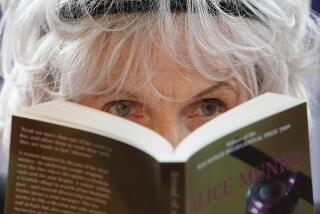Jane’s Calamities : BUFFALO GIRLS <i> By Larry McMurtry (Simon & Schuster: $19.95; 351 pp.; 0-671-68518-X) </i>
- Share via
Whenever Larry McMurtry sits down at the campfire of modern fiction, a wild cast of characters soon amble in from the shadows, and their compelling yarns quickly edge any weighty issues into the background. So it is in this tale of Martha Jane Canary, better known as Calamity Jane, as she and her companeros ramble across their old stompin’ grounds, from the great plains of the Dakotas to the mountains of Montana and Wyoming, aimlessly seeking some vague goal that they all sense can no longer be found.
The Indian wars are over, the buffalo gone, and the romance of the West withers even as the legends it spawned blossom. The challenges of the old West took a physical toll, but this transitional era leaves folks without purpose. While the only violence in this novel happens “off stage,” there is plenty of pain to go around. Now it is the characters’ souls that get a sound whomping.
In her younger days, Jane loved to “drink and sing and hoorah” with the cowboys. As “Buffalo Girls” unfolds, though, her carousing has become a form of self-administered anesthesia, rather than a celebration of the West’s huge freedom. None of this is lost on the friends who wander in and out of Jane’s life, including mountain men Bartle Bones and Jim Ragg, an old Ogalala Sioux named No Ears and Jane’s best friend Dora DuFran, who runs a Miles City saloon and whorehouse named Hotel Hope.
The central irony of the story is that the only hope of salvation for these characters arrives in an offer from their old friend Buffalo Bill, who convinces them that they might recapture their past glories--real or imagined--by joining his Wild West Show for a performance before Queen Victoria in London. In their hearts, Jane and her friends see the paradox. As Bartle says: “If Billy Cody can make a poster of it, then there ain’t no Wild West.” But Jane understands how desperately people can cling to foolish hopes. Eventually, she and her friends join Cody, Annie Oakley, Sitting Bull and other characters from the history books and McMurtry’s imagination to condense the shoot-’em-up history and myth of the West into a sort of live-action miniseries, there in the heart of the civilization their forebears abandoned.
It is fruitless to try and figure out how closely McMurtry sticks to facts here, because so many of the figures in this novel, as in “Anything for Billy” before it, were mired in legend long before McMurtry plucked them from their graves.
But the mythologizing of history is only part of what “Buffalo Girls” is about. Both the characters and their country are struggling with middle age and the possibility that “the fun is over,” and this discussion of loss and maturity also drives the book.
Because “the fun” often was so excessive, for instance, the characters are left to face regrets. The West, Bartle concedes wistfully, has been “used up.”
“ ‘I blame it on the Indians,’ he says. ‘They gave up too soon.’ ” But he knows where the real blame lies: “What a monstrous mistake it had been to popularize buffalo hunting. Millions of them had roamed the plains--it still seemed hardly credible to men who had seen the great herds in their glory that so many animals could be killed in only three years. But it had occurred: It weakened the Indians, armies had marched, brave men had died, and now they were to down to expositions.”
In one of the more poignant scenes in a book full of them, Jim Ragg, who has been inconsolable since he faced the realization that the beaver had gone the way of the buffalo, finds an exhibit of live American beaver at the London zoo.
For days, he sits and watches the animals he spent his life trapping, his faith in the world renewed.
In another wonderful scene, No Ears, perhaps the most engaging character in the book, seems to foresee the continued destruction of the world’s resources. As he sits on the boat that is taking the show to England, enthralled by the ocean, the vast “herds” of fish flashing beneath the waves remind him of the buffalo charging in seemingly endless profusion over the plains.
McMurtry tells his story in part through letters supposedly written by Jane to her daughter Janey, whom she has sent away to live with a well-to-do city couple. Recently, several male writers--Jay McInerney, Reynolds Price and Jim Harrison among them--have attempted to write from a woman’s viewpoint, with mixed results. Some feminist critics even have chastised them for their arrogance. The real Jane did write letters to a supposed daughter, but with McMurtry’s grip on Calamity’s pen, these letters take some unusual twists, and the gender issue in “Buffalo Girls” is complicated by the fact that Jane is an unusually well-balanced mix of masculine and feminine traits. Even the delicate issue of Jane’s suspect womanhood, however, becomes almost insignificant in the sprawling context of the West--where, as McMurtry portrays things, tolerance is as important a survival technique as knowing how to crawl into the still-warm belly of a slaughtered buffalo in a blizzard.
Wisely, McMurtry keeps the epistolary tactic reined in. Jane’s voice is merely an intriguing subtext to his own much richer narrative voice. It is McMurtry’s description and dialogue and character, after all, that make readers plunge into the author’s books the way some people fall into soap operas, wanting to spend as much time with his imagined people as possible, even though the characters are often thoroughly disagreeable.
In this sense, “Buffalo Girls” is “Lonesome Dove” writ small. The book rolls along on anexistential current of melancholy, in contrast to which the moments of joy and hilarity are especially vivid. The good old days are gone, and most of these people will have no part in what follows.
Returning to the West from England, No Ears finds his people demoralized, lacking even the survival instinct to listen to the old man’s spiritual wisdom. Jane and her companeros have grown lazy and confused, unwilling to embrace the myths they are becoming, yet living in their own self-embellished pasts. As Jane writes: “Now all I do is piddle around in my memories. You’ve seen children make mud pies? That’s what I do with my memories, I pat them into the shape I want them to take.”
Still, there is something about these people and their passion for life that makes you want to be with them. You want to sit in the dirt and share that old prairie dog that Jim Ragg has just cooked over a barely flickering fire, even though he suspects it may be diseased. Why? Because set against the overwhelming vastness of the West, and of life, tolerable companionship looks awfully good. Despite the mundane sadness and glorious tragedy that stalks them, McMurtry’s characters seem to understand that life is, as one cowboy put it, “a sturdy business.”
How the West was won (or lost) doesn’t make all that much difference here. History happened, and that’s that. What matters is that the world was kept from flying apart by something as simple as friendship.
More to Read
Sign up for our Book Club newsletter
Get the latest news, events and more from the Los Angeles Times Book Club, and help us get L.A. reading and talking.
You may occasionally receive promotional content from the Los Angeles Times.










